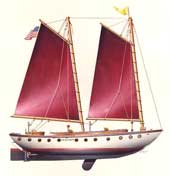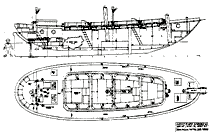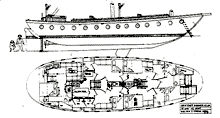I think that most boat projects initially
start with a fuzzy dream. Then, as the dream progresses
and becomes more focused, we realize it can be a ton
of work, money, and time, to get the damned thing
completed. This is especially true if the boat is
over 25 ft, and progresses exponentially as you go
bigger. The work can sap both physical and mental
energy, the time drags on, and the money is sucked
up like a black hole is in the center. Sometimes the
project takes on a life of it’s own, and drags
you along from step to step. Each step doable, but
at an ever increasing cost of time, energy, and money.
That’s the way the plan for my Schooner seemed
to go, and not a single bit of steel was laid down
for more than a year while it was in the planning
stage. But I’m getting ahead of myself with
this tale. The tale of my dream boat that I never
built but sometime wish I had - A Big River Schooner
- an ego Schooner for sure.
 |
This is the
tale of a dream boat that I never built but
sometimes wish I had - A Big River Schooner
- an ego Schooner for sure. |
I designed her in 1990 when I had the energy, the
time, and money enough to get her started. I knew
I could raise the needed funds to complete her once
she was under construction. It’s not hard to
get investors when you have a crazy enough plan, and
a way to make it happen. The design chosen was a 62
ft steel scow schooner, with a day-sailing deck arrangement
and 6 staterooms for live-aboard cruising. She would
be a very impressive sight on the River in Saint Louis,
with her red sails bent to the river winds. I chose
62 ft for two reasons-because it comes in just under
the coast guard tonnage for licensing purposes, and
that’s the longest boat I could design on my
tri-scale. The scow schooner rig was chosen for its
simplicity and its safety features. There is always
a safety concern about passengers on board getting
tangled in the rigging gear, or the sail handling
sheets and halyards. With the simplicity of the scow
rig, everything is high overhead, with all lines handled
from the aft cockpit. Under way with guests aboard,
the boat would be run as a motor sailor with both
engine and sails. She was flat bottomed for shallow
draft, with a rounded bow and stern. Although the
design seems complicated, it really should not have
been difficult to build with its wooden shoe lines
and shape. There would need to be some rolled sections,
but a competent fabrication shop could handle these
sections easily. The side plates and decks were quarter
inch, and the bottom was three eighths. The draft
is four feet six inches with a large centerboard and
a bow thruster for close in turning control. The engineering
for stability in differing wind speeds and conditions
was done by Jim Michalak.
I saw a similar boat design from the European trades
that hauled commodities around the coastal islands.
Somehow everything just seemed right about the lines
and the simplicity of construction of that boat. It
had a huge hull capacity for the 6 interior staterooms,
and loads of deck space with 4 cockpits for on deck
cruising comfort and sitting space for 24-30 persons.
| Somehow everything
just seemed right about the lines and the simplicity
of construction of that boat. |

|
A promotional plan was created to promote the boat
prior to construction. The plan was to introduce a
number of individuals and companies to the project
- to lay the groundwork for the project, and then
come back to those same parties in the future to act
either as investors or corporate clients. To show
what the Schooner would become, we had an artist’s
rendering done that gave a finished image of the ship
under sail. We had several large photo images of the
rendering produced that could be presented to heads
of corporations for framing and hanging in their offices.
We made a scale model that could be used for group
or individual sales presentations. We asked for input
from the people who could add to the promotion.
The company that makes Awlgrip Paints offered to
provide all the interior and exterior paints and varnishes
for the complete boat in exchange for using the Schooner
as a test lab for their products. They also asked
for permission to use the image of the Schooner in
their advertising literature. We made “Great
River Schooner” buttons that were presented
to individuals for future boarding discounts. If added
funds were needed, we would offer to weld their name
into the deck plate of the schooner for a $100 donation
to the project. Your welded name would be the non-skid
forever imprinted on the Schooner.
The reception to the idea of the Great River Schooner
was phenomenal. It was so easy to get these corporate
leaders to buy into the promotion presented. They
loved it! When would it be available? Every indication
was a go for building the Schooner.
 |
We made a scale
model that could be used for group or individual
sales presentations. |
Plan One
The first plan was to own her outright, and use her
as a day charter boat on the 25 mile stretch between
Alton and Grafton Illinois. This wide 25 mile area
has the most scenic view anywhere on the river with
its high white bluffs and wooded islands. The charter
sales emphasis was to be on a corporate clientele.
During the week, corporations could charter the Schooner
for sales meetings, special promotions with selected
groups of clients, for annual company picnics, or
other periodic special events. If they had clients
in town during the week, they could also charter the
Schooner for overnight sleeping accommodations for
these special guests. Very impressive!
Then on weekends, we could run the Schooner for the
public with scheduled departures for tourists during
the day, and evening and midnight cruises at night.
Moonlight sailing with romantic music, and the breeze
blowing in the rigging and in your face. Very, very
impressive!
In the fall the Schooner could cruise north to watch
the foliage change, or go on eagle watch day cruises
for the public, and also for the local schools and
universities, who could charter the boat for special
events, for graduation parties or for study of the
river environment. After the fall season, she could
be chartered to four couples for a down river cruise
to New Orleans for the winter, and chartered back
in the spring for the summer season events. Because
of its uniqueness, it could also be used as a stage
for local or national advertising promotions. In a
word, it should be able to pay its way for the anticipated
operating expenses and needed insurance. As long as
it generated enough revenue to pay the way, anything
is possible for a business Schooner that hopefully
would become a community icon.
Plan Two
This plan was to use the Schooner as a church. A
church that is used for Sunday services. Then used
as an income producer with a “Plan One”
activities incorporated. The net income generated
could be used for charitable expenditures. Because
of its unique offerings, it should be able to attract
a great following. It could also offer charters for
other churches who want a special events platform.
The church members could participate in the construction
and painting of the schooner.
Part of the church offering could be weddings and
wedding party events. What could be more exciting
than getting married aboard a real sailing Schooner,
or having a wedding party event on board before getting
married the next day in a home church. If the Schooner
was a church with the proper tax registry, contributions
could be tax deductible! The Schooner would be owned
and maintained by the church entity.
Finally, after over a year of planning the boat,
and doing the construction drawings, the Great River
Schooner was submitted to the Coast Guard for licensing.
With a few modifications to the plans, the boat could
be approved for 49 passengers and a 25-ton Captains’
licensing requirement. The changes required were minimal
and could be done as the boat was constructed.
The building plan was to fabricate
the boat in three parts- two twenty foot sections
aft and center, and one twenty-two foot bow section.
The sections were joined cross ship at joint mirror
frames that were bolted in place, and then welded
together onto the keel backbone. For fabrication,
each of the three construction sections (stern, center,
bow) would be lofted for framing that was split down
the center, and then welded to the backbone center
keel forming the completed boat. This sectional construction
allowed the boat to be fabricated off site, and then
come together for the final assembly of the six individual
fabricated units. By using the sectional plan, you’d
save tons of money for yard time and storage over
an extended building program. It would also allows
for the storage of the completed units offsite until
the final coming together.
Each of the 6 finished sections was to be a maximum
of 9 ft wide, 20 ft long, and 7 ft high, and could
be easily stored and transported to the assembly site
when needed. The fabrication of these sections could
also be done indoors, thus allowing for inclement
weather fabrication and welding. Indoor welding also
provides the advantage of clean no-slag mig welding,
instead of dirtier stick welding in windy and wet
outdoor conditions. Your focus during construction
is then only on one doable unit at a time. Sectional
construction is not my idea or anything new. It’s
the way they build large commercially constructed
boats everywhere.
| The building
plan was to fabricate the boat in three
parts- two twenty foot sections aft and center,
and one twenty-two foot bow section. |

|
Assembly
Once the sections are fabricated the assembly can
begin. The starboard aft 20 ft section would be set
in place and welded to the keel. The off center motor
can then be installed easily at ground level instead
of lifting the heavy 671 Detroit diesel over the top
and then lowered down. Because only the starboard
half of the aft section is in place, you could simply
run the heavy diesel motor up to the keel with a fork
lift, and set it onto the pre-fabricated mounts installed
in the starboard aft section that has been welded
in place. With the engine bolted and aligned in place
with the fork lift, the port aft 20 ft section would
then be welded in place. The aft 33% of the boat is
now in place and attached to the keel. The interior
bulkheads and accommodation construction of the stern
and deck 20 ft sections could now be roughed in. Again,
the work can be done at ground level. You are coming
at the boat’s interior from ground level by
walking into the forward open part of the aft section.
The interior ground level assembly of the ship as
it goes together can save a ton of lifting gear and
the need to hoist components up over the rail and
down into the vessel.
After the aft 20ft section deck and interior are roughed
in, you proceed forward with the two center sections,
working from the ground again. You can now do the
interior and deck construction of the middle 33%.
When the center sections are on and welded to the
keel, put the first of the two bow sections in place
and weld it in place. Again, do the needed interior
and deck construction on that section before attaching
the remaining bow section. To assure the exact alignment
of the six sections, sister mirror frames are made
for both port – starboard joints, on the cross
frames between the sections and also center- joint
mirror frames. In doing so, you really only have one
set of lines for each of the 3 sections, and then
make a mirror frame for the other side.
All of the plans for building the boat were in place
prior to laying the composite I beam and ferro cement
keel at the assembly marina. Arrangements for the
location of both the sections assembly and the marina
yard for final assembly and launch were made. A time
schedule and material source to do each of the necessary
beginning steps, and the funds to get under way were
waiting for the initial kick off of the project. Every
thing was a go.
Time to start was penciled in on my calendar. Major
steps, minor steps, and individual construction tasks
were computed and entered onto the construction calendar.
Computations and arrangements were made for all the
materials needed to do the first month’s activity.
Reality Creeps In
Most boat builders go through three mental stages
in their building projects - at least I do. The first
stage is rationalization when they choose what to
build, and how to build it. . Put everything down
on paper and it looks doable, and even affordable
and simple. The next stage is falling in love. At
his stage, after you have rationally decided what
to build, it becomes more than a boat. Instead, it
becomes a love object in your life, and maybe even
the most important one. The third, and often most
fatal stage is, you go nuts. At this last stage you
can become very irrational and dangerous to your financial
and personal physical well being. That’s the
way it happened to me anyway.
However, at the last minute just before I began,
I came to my senses and decided not to build the Schooner
after all. I decided it was just too large a project
for me to tackle at that time of my life. I knew then,
and I know now, that it was possible to do, but I
didn’t have the burn in my guts to make such
a commitment of time, energy, and the money to do
the deal. I also kept looking over my shoulder to
see if my friend Sven was creeping up behind me to
kick me back into reality.
I can’t say how it would have turned out if
I had built it, and I often wonder if it would have
been the culmination of a dream I had at the beginning.
My fifteen minutes of fame was cancelled at the fourteenth
minute. Did I fail to realize a doable and exciting
dream, or did I escape from a disastrous nightmare
just about to begin?
Every now and then I get the plans for the schooner
down and flip through the pages that were drawn over
fifteen yeas ago. When I do, I get a good feeling
about the boat, but I’m not really sorry I took
a pass at the last minute. If you want to take a stab
at building her, I’ll gladly be your Project
Manager for a substantially reduced rate. The construction
plans are still available for a hearty soul who is
searching for the ultimate boat-building project.
I also have several high quality large photos of the
rendering that you can purchase if you are interested
in starting a new dream project yourself. I believe
that going nuts over a Dream Schooner isn’t
really a bad thing, especially if everyone thinks
you are a little nuts even before the project is discovered.
When you are suspected of being “nuts”
you don’t have to explain anything to anybody.
Pity for my “condition” is very comforting
to me, but I do still love the idea and image of that
Schooner. Maybe when I’m in the home I will
build her in my mind. Step by step, I can rock in
my chair with a smile in my face as I build her day
after day. Harold
Lets talk- Harold oneuglyboat@hotmail.com
About Harold Duffield: - age
67 - grew up on the Mississippi River - was whats
known as a "river rat". He has been messing
about and building boats for over 50 yrs. Now he
is offering plans and kits for fishing boats, shantys,
house boats and even sailboats in aluminum as well
as finished boats. https://www.oneuglyboat.com/

Other articles by Harold Duffield:
|